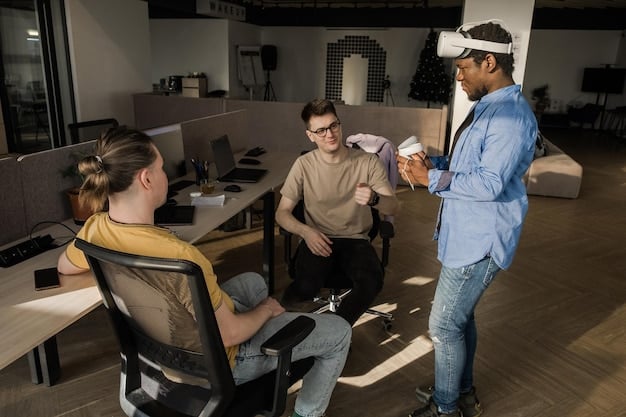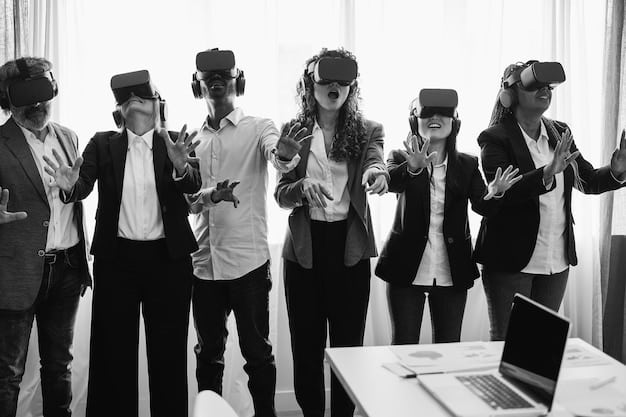The Metaverse and Future Work: Virtual Collaboration in US Companies

The Metaverse is transforming the future of work for US companies by enabling immersive virtual collaboration, enhancing employee engagement, and creating new opportunities for training and innovation.
The metaverse and the future of work: exploring virtual collaboration in US companies is rapidly evolving, offering US businesses unprecedented opportunities for innovation and efficiency. This article delves into how metaverse technologies are reshaping the American workplace.
Understanding the Metaverse: A New Frontier for US Businesses
The metaverse, once a concept of science fiction, is now becoming a tangible reality for businesses across the United States. Its potential to revolutionize how companies operate is immense, particularly in enhancing virtual collaboration.
This section explores the core components of the metaverse and its applicability to future work environments in the US.
What is the Metaverse?
The metaverse is a persistent, shared, 3D virtual world or worlds that are interactive, immersive, and collaborative. It combines multiple elements of technology, including virtual reality (VR), augmented reality (AR), and video, where users can “live” within a digital universe.
For US companies, understanding this technology is crucial as it presents new ways to engage with employees, customers, and partners.
Key Components of a Functional Metaverse for Work
For the metaverse to be effectively integrated into workplace settings, it needs specific capabilities that cater to professional needs:
- Immersive Collaboration Tools: Platforms that offer realistic virtual environments for meetings, brainstorming sessions, and collaborative projects.
- Seamless Integration: The ability to integrate with existing software and tools used by companies daily.
- Scalability: The capacity to accommodate a growing number of users without compromising performance.
- Security: Robust measures to protect data and ensure privacy within the virtual environment.
The metaverse offers a synergistic blend of virtual and physical worlds, creating novel experiences that drive engagement and productivity in various sectors.

Enhancing Virtual Collaboration through Metaverse Technologies
The implementation of metaverse technologies is set to dramatically enhance virtual collaboration within US companies. By providing immersive and intuitive digital environments, the metaverse enables more effective communication and engagement, regardless of physical location.
This section examines various innovative methods through which the metaverse can transform virtual collaboration.
Virtual Meeting Spaces
Traditional video conferencing often falls short in replicating the dynamics of in-person meetings. The metaverse addresses this limitation by providing interactive virtual meeting spaces where participants can:
- Interact in 3D Environments: Create avatars and navigate through virtual offices.
- Share and Manipulate 3D Objects: View and interact with virtual models and simulations.
- Experience Spatial Audio: Enhance communication clarity by simulating real-world sound dynamics.
Training and Development
The metaverse offers dynamic, hands-on training environments. Employees can undergo simulations that closely mimic real-world scenarios, providing a safe and engaging learning experience. Key benefits include:
- Realistic Simulations: Providing practical experience in a risk-free environment.
- Personalized Learning Paths: Tailoring training to individual skill levels and needs.
- Immediate Feedback: Allowing real-time assessment and correction of performance.
The metaverse offers these benefits and more, leading to a more skilled and engaged workforce. This advancement signals a significant shift towards interactive and effective learning methodologies in the workplace.
By providing immersive virtual environments, the metaverse enables teams to collaborate more effectively, fostering innovation and improving productivity.
Examples of US Companies Leveraging the Metaverse for Work
Several pioneering US companies are already harnessing the power of the metaverse to transform their workflows and elevate employee engagement. These initiatives offer valuable insights into the practical applications and benefits of metaverse technologies in the workplace setting.
This section explores some of these successful implementations.
Case Study: Retail Training Simulation
A major US retail chain implemented a metaverse-based training program for its store employees. Through VR simulations, new hires were trained on various aspects of store operations, like:
- Customer Interaction: Learning how to handle different customer scenarios in a realistic setting.
- Inventory Management: Practicing restocking shelves and organizing products efficiently.
- Point of Sale Operations: Mastering the checkout process and handling transactions.
Case Study: Engineering Design Review
An American engineering firm has integrated the metaverse into its design review process. Engineers from different locations can now collaborate in a shared virtual space to:
- Inspect 3D Models: Examining designs from all angles in a detailed virtual environment.
- Annotate and Modify: Providing direct feedback and making real-time adjustments to the designs.
- Reduce Errors: Identifying potential issues early in the design phase.
The metaverse provides not only a space for innovation but also a means for companies to push the boundaries of what’s possible, making a significant impact on their respective industries.

Challenges and Considerations for Metaverse Adoption in US Workplaces
While the potential benefits of adopting the metaverse in US workplaces are significant, there are also several challenges and considerations that companies must address to ensure successful implementation. These include technological limitations, security concerns, and the need for employee training.
This section delves into these critical factors.
Technological Infrastructure
One of the main hurdles is the current state of technological infrastructure. For the metaverse to function seamlessly, companies need to ensure:
- High-Speed Internet: Reliable and fast internet connectivity is essential.
- Advanced Hardware: Access to VR headsets, AR glasses, and other necessary devices.
- Software Integration: Compatibility of metaverse platforms with existing company systems and software.
Security and Privacy
Data security and privacy are paramount when integrating the metaverse into business operations. Important considerations include:
- Data Protection: Implementing robust security measures to protect sensitive information.
- Privacy Policies: Establishing clear guidelines on data collection and usage within the metaverse.
- User Authentication: Ensuring secure access through multi-factor authentication and other methods.
The adoption of the metaverse brings complexity, but also a chance to redefine business operations.
The Role of Leadership in Implementing Metaverse Strategies
Effective leadership is crucial in guiding US companies through the transition into metaverse-integrated workplaces. Executives and managers need to spearhead the development of clear strategies, foster a culture of innovation, and ensure that employees are equipped to navigate this new digital landscape.
This section emphasizes the responsibilities of leadership in driving successful metaverse adoption.
Setting a Clear Vision
Leaders need to articulate a clear vision for how the metaverse will enhance the company’s strategic objectives. This involves:
- Defining Goals: Establishing specific, measurable, achievable, relevant, and time-bound (SMART) goals.
- Communicating Benefits: Clearly explaining the value proposition to employees and stakeholders.
- Aligning Resources: Allocating necessary resources to support the implementation.
Fostering a Culture of Innovation
Creating an environment that encourages experimentation and learning is essential. Key steps include:
- Encouraging Experimentation: Supporting pilot projects and proof-of-concept initiatives.
- Providing Training: Offering comprehensive training programs to upskill employees.
- Celebrating Successes: Recognizing and rewarding innovative ideas and implementations.
The leadership role is to create a space of open minds and constant learning, where new technologies can improve the entire organization.
Future Trends and Predictions for the Metaverse in US Companies
As the metaverse continues to evolve, several key trends and predictions can help guide US companies in their strategic planning. These developments are likely to shape how businesses operate, collaborate, and innovate in the near future.
This section highlights some of these emerging trends.
Enhanced AR/VR Integration
Advancements in augmented and virtual reality technologies will lead to more immersive and seamless experiences. Key trends include:
- Improved Hardware: Lighter, more powerful VR headsets and AR glasses.
- Better Software: More intuitive and user-friendly metaverse platforms.
- Increased Adoption: Wider use of AR/VR in training, collaboration, and customer engagement.
AI-Driven Metaverse Experiences
Artificial intelligence will play a crucial role in creating personalized and dynamic metaverse environments. Key advancements include:
- Intelligent Avatars: AI-powered avatars that can understand and respond to user interactions.
- Automated Content Creation: AI tools that can generate virtual environments and content.
- Predictive Analytics: Using AI to optimize user experiences and improve business outcomes.
The future of the metaverse in the US is ripe with promise, calling for companies to act as pioneers in this digital expansion.
| Key Point | Brief Description |
|---|---|
| 💡 Virtual Collaboration | Enhances team interaction through immersive virtual environments. |
| 🚀 Training Simulations | Provides realistic, risk-free training scenarios for employees. |
| 🔒 Security Concerns | Addresses data protection and privacy in virtual environments. |
| 📈 AI Integration | Boosts performance with intelligent avatars and automated content creation. |
Frequently Asked Questions
▼
The metaverse is a shared, immersive virtual world where users can interact in various ways. For businesses, it provides new avenues for employee collaboration, customer engagement, and innovative business models.
▼
The metaverse enables more realistic and engaging virtual meetings, improved training through virtual simulations, and enhanced teamwork despite geographical distances. This can result in increased productivity and innovation.
▼
Companies should consider technological infrastructure requirements, data security and privacy concerns, and the need for employee training to effectively use metaverse platforms. Scalability and integration with existing systems are also important.
▼
AI in the metaverse allows for personalized avatars, automated content creation, and predictive analytics to optimize user experiences. It can also provide real-time feedback during training sessions and improve overall metaverse interactions.
▼
Leadership needs to define a clear vision, foster a culture of innovation, allocate necessary resources, and ensure that employees are adequately trained on metaverse technologies. Their support is crucial for driving adoption and achieving strategic goals.
Conclusion
The metaverse presents a transformative opportunity for US companies to redefine the future of work by enhancing virtual collaboration, improving training and development, and fostering innovation. While there are challenges to address, the potential benefits are immense, making it essential for businesses to explore and strategically implement metaverse technologies.





